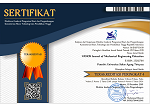Developing Tutorial Video Chassis Maintenance for Automotive Students at SMK Negeri 1 Seyegan
Abstract
The primary objective of this study is to develop tutorial videos addressing periodic maintenance procedures for light vehicle chassis at intervals of 5000, 10,000, 20,000, and 40,000 kilometers, while also assessing their suitability for educational purposes. The Research and Development (R&D) methodology, utilizing the ADDIE model, was employed for this purpose. The R&D process encompasses analysis, design, development, implementation, and evaluation stages. The study was conducted at SMK Negeri 1 Seyegan, where content and media experts served as respondents to evaluate the appropriateness of the tutorial videos. Additionally, 96 students from Class XI of the Automotive Light Vehicle Engineering department participated in trial sessions to assess the videos' usefulness. Data were gathered through interviews and questionnaires, followed by thorough analysis to elucidate the study's findings. The results revealed that the tutorial videos received very high ratings from content experts (96.5%) and favorable ratings from media experts (79.8%). Moreover, students, as potential users, gave the videos a high score of 80.43%. These findings indicate that the tutorial videos are well-suited for implementation in practical classroom activities.
Keywords
Full Text:
PDFReferences
J. M. Lanicci and S. K. McCorrison, “Why K-12 education is important to achieving a Weather-Ready Nation,” J. Geosci. Educ., vol. 71, no. 2, pp. 266–277, 2023.
Daryanto, Media pembelajaran. Yogyakarta, 2016.
R. Sancar, D. Atal, and D. Deryakulu, “A new framework for teachers’ professional development,” Teach. Teach. Educ., vol. 101, p. 103305, 2021.
R. Indonesia, Undang-Undang Republik Indonesia Nomor 20 Tahun 2003 Tentang Sistem Pendidikan Nasional Dengan Rahmat Tuhan Yang Maha Esa Presiden Republik Indonesia. Jakarta, 2003.
L. C. Yuswono, Martubi, and Sukaswanto, “Profil Kompetensi Guru Sekolah Menengah Kejuruan Teknik Otomotif di Kabupaten Sleman,” J. Pendidik. Teknol. dan Kejuru., vol. 22, no. 2, 2014, doi: 10.21831/jptk.v22i2.8925.
M. R. Prihantono, T. Usman, and M. Wakid, “The development of learning media’s ‘tutorial video for setting the front wheel alignment with a 3d spooring tools’ at SMK N 1 Magelang,” in Journal of Physics: Conference Series, 2020, vol. 1700, no. 1, p. 12061.
S. Purnomo, P. N. Fatkhurahman, A. Efendi, N. Handoyono, and R. Rabiman, “Development of Motorcycle Brake System Tutorial Media for Vocational High School,” in Proceedings of the International Conference on Technology, Education, and Science, 2023, vol. 5, no. 1, pp. 63–72.
B. J. Waruwu, N. Jalinus, R. E. Wulansari, and W. Purwanto, “Development of Short Tutorial Video Learning Media Instagram in the Motorcycle Chassis Maintenance Courses at Vocational High Schools,” Indones. J. Comput. Sci., vol. 12, no. 4, 2023.
N. Elpira and A. Ghufron, “Pengaruh penggunaan media powerpoint terhadap Minat dan hasil belajar ipa siswa kelas IV SD,” J. Inov. Teknol. Pendidik., vol. 2, no. 1, pp. 94–104, 2015.
T. Tafonao, “Peranan media pembelajaran dalam meningkatkan minat belajar mahasiswa,” J. Komun. Pendidik., vol. 2, no. 2, pp. 103–114, 2018.
H. W. Sanjaya, Media komunikasi pembelajaran. Prenada Media, 2016.
A. Irawan and D. Widjanarko, “Pengembangan Alat Peraga Sistem Audio untuk Meningkatkan Pemahaman Mahasiswa Pendidikan Teknik Otomotif,” J. Pendidik. Vokasi Otomotif, vol. 2, no. 1, pp. 1–10, 2019.
S. Anshor, I. G. Sugiyanta, and R. K. S. Utami, “Penggunaan media pembelajaran berbasis video terhadap aktivitas dan hasil belajar geografi,” J. Penelit. Geogr., vol. 3, no. 6, 2015.
W. Dick, L. Carey, and J. O. Carey, “The systematic design of instruction,” 2005.
I. W. Djatmiko, “Strategi Penulisan Skripsi, Tesis & Disertasi Bidang Pendidikan.” UNY Press, 2018.
K. Sukiyasa and S. Sukoco, “Pengaruh media animasi terhadap hasil belajar dan motivasi belajar siswa materi sistem kelistrikan otomotif,” J. Pendidik. Vokasi, vol. 3, no. 1, 2013.
S. Suyitno, “Pengembangan multimedia interaktif pengukuran teknik untuk meningkatkan hasil belajar siswa SMK,” J. Pendidik. Teknol. Dan Kejuru., vol. 23, no. 1, pp. 101–109, 2016.
K. Ummah, M. S. Ami, and O. P. Y. Meishanti, “Pengembangan modul pembelajaran biologi berbasis Reading, Questioning, and Answering (RQA) materi virus kelas X,” J. Biol. Dan Pembelajarannya, vol. 8, no. 1, pp. 19–25, 2021.
A. V. S. Aji and I. Siswanto, “Pengembangan video tutorial membuat media pembelajaran berbasis android menggunakan adobe animate cc,” J. Taman Vokasi, vol. 9, no. 2, pp. 141–148, 2021.
D. T. Santosa and Tawardjono Us, “Faktor-faktor penyebab rendahnya motivasi belajar dan solusi penanganan pada siswa kelas XI jurusan Teknik Sepeda Motor,” E-Jurnal Pendidik. Tek. Otomotif S1, vol. 3, no. 2, pp. 14–21, 2016.
C. Riyana, “Pedoman pengembangan media video,” Jakarta P3ai Upi, pp. 2552–2654, 2007.
I. Siswanto, Sukaswanto, Purwanto, N. N. Fatin, and A. V. S. Aji, Teori dan Pengembangan Media Pembelajaran Teknik Otomotif. Yogyakarta: UNY Press, 2024.
T. Nurseto, “Membuat media pembelajaran yang menarik,” J. Ekon. dan Pendidik., vol. 8, no. 1, 2011.
G. Lai, Z. Zhu, and D. Williams, “Enhance students’ learning in business statistics class using video tutorials,” J. Teach. Learn. with Technol., vol. 6, no. 1, pp. 31–44, 2017.
Y. S. Aldjufri, I. Siswanto, and N. Setiawan, “Developing wiper and washer system media for automotive engineering learning,” in AIP Conference Proceedings, 2023, vol. 2671, no. 1.
N. M. Preradovic, T. Lauc, and I. Panev, “Investigating interactivity in instructional video tutorials for an undergraduate informatics course,” Issues Educ. Res., vol. 30, no. 1, pp. 203–223, 2020.
N. Bahiyah, “Revolutionizing Education: Unlocking the Potential of Asynchronous Video for Interactive Online Learning,” Int. J. Educ. Humanit., vol. 3, no. 2, pp. 187–196, 2023.
DOI: http://dx.doi.org/10.30870/vanos.v9i1.25986
Refbacks
- There are currently no refbacks.

This work is licensed under a Creative Commons Attribution 4.0 International License.


.png)
.png)
